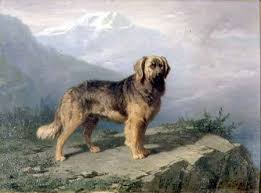
Alpine Mastiff
Conditions of detention
The Alpine Mastiff thrived in spacious environments where it could move freely and perform its guarding duties. They were not suited for apartment living due to their large size and need for exercise.
Useful Fact: These dogs required a large yard or open space to roam and exercise, which helped keep them healthy and active.
Nutrition and diet
A balanced diet rich in high-quality protein was essential for the Alpine Mastiff to maintain its muscle mass and overall health. Their diet needed to support their large size and active lifestyle.
Useful Fact: Feeding them two to three smaller meals a day, instead of one large meal, could help prevent bloat, a common issue in large breeds.
Health
The Alpine Mastiff, like many large breeds, was prone to specific health issues such as hip dysplasia, bloat, and heart problems. Regular veterinary check-ups were essential for maintaining their health.
Useful Fact: Maintaining a healthy weight through proper diet and regular exercise could help reduce the risk of joint issues and other health problems.
Grooming and care
The Alpine Mastiff had a short, dense coat that required minimal grooming. Regular brushing helped keep their coat healthy and reduced shedding.
Useful Fact: Bathing was needed only occasionally, as over-bathing could strip the coat of natural oils. Regular ear cleaning and dental care were also important.
Education and training
These dogs were intelligent and trainable but could be stubborn. Consistent, positive reinforcement training methods worked best.
Useful Fact: Early socialization and obedience training were crucial to ensure they grew into well-behaved and manageable adults.
Toys and entertainment
Alpine Mastiffs enjoyed activities that challenged them physically and mentally. Durable chew toys, interactive toys, and activities like obedience training and tracking were ideal.
Useful Fact: Providing them with tasks or jobs, such as carrying packs, could keep them mentally stimulated and satisfied.
Safety
Ensuring a secure environment was essential for the Alpine Mastiff, given their size and strength. Proper fencing and supervision during outdoor activities were important.
Useful Fact: Training them to respond to basic commands like “stay” and “come” was crucial for their safety and the safety of others.
Accessories
Essential accessories included a sturdy leash and collar, identification tags, and a comfortable bed. Durable chew toys and grooming tools were also important.
Useful Fact: Given their size and strength, high-quality, durable accessories were necessary to handle them safely.
Socialization
Early and ongoing socialization with different people, animals, and environments was vital for the Alpine Mastiff to develop a balanced temperament.
Useful Fact: Socialization helped prevent overprotectiveness and aggression towards unfamiliar people or animals.
Travel and Transportation
Traveling with an Alpine Mastiff required planning due to their large size. A secure crate or harness was essential for car travel to ensure their safety.
Useful Fact: Introducing them to travel gradually could help them become more comfortable with the process and reduce anxiety.
Behavior and psychology
The Alpine Mastiff was known for its intelligence, loyalty, and protective nature. They needed mental and physical stimulation to stay happy and balanced.
Useful Fact: Regular interaction and activities that engaged their mind and body were crucial to prevent boredom and destructive behaviors.
Legal aspects
Familiarizing oneself with local pet laws, including licensing, leash requirements, and breed-specific legislation, was essential to ensure compliance and avoid legal issues.
Useful Fact: Many regions required large breeds to be registered and microchipped, which helped in identifying and returning lost pets.


